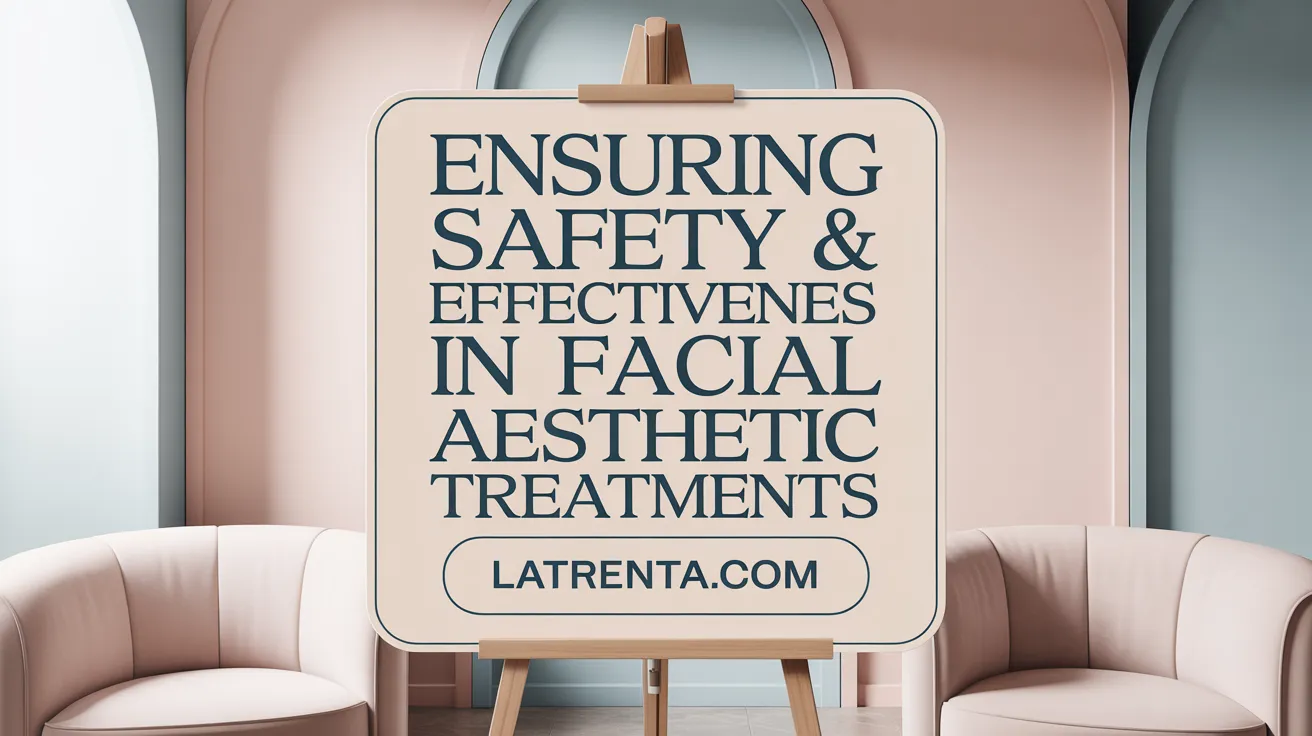Embracing the Future of Facial Refinement
In the quest for a youthful appearance, facial rejuvenation techniques have evolved dramatically, blending science, artistry, and technology. From minimally invasive injectables to advanced energy-based devices, today’s innovations offer tailored, natural-looking solutions that address aging’s many facets—wrinkles, volume loss, skin laxity, and pigmentation. This article explores the latest breakthroughs, treatment modalities, and expert insights shaping the future of facial refinement, empowering readers to achieve rejuvenated skin with confidence and safety.
Minimally Invasive and Non-Surgical Breakthroughs in Facial Rejuvenation
 Facial rejuvenation today involves a broad range of minimally invasive and non-surgical facial rejuvenation treatments designed to restore a youthful, natural appearance with minimal downtime. These procedures include injectables like botulinum toxin, dermal fillers, thread lifts, and skin resurfacing treatments.
Facial rejuvenation today involves a broad range of minimally invasive and non-surgical facial rejuvenation treatments designed to restore a youthful, natural appearance with minimal downtime. These procedures include injectables like botulinum toxin, dermal fillers, thread lifts, and skin resurfacing treatments.
Injectables such as Botox and Dysport are neuromodulators derived from bacteria. They work by temporarily blocking nerve signals to muscles, relaxing facial muscles that cause dynamic wrinkles like crow’s feet, frown lines, and forehead lines. Techniques like micro-Botox and baby Botox utilize diluted or lighter doses of botulinum toxin to achieve a very natural, subtle smoothing effect, particularly on fine lines and pores, often with effects lasting around three to four months.
Dermal fillers, made from substances such as hyaluronic acid, calcium hydroxylapatite, and poly-L-lactic acid, are used to restore lost volume, enhance facial contours, and smooth static wrinkles. Hyaluronic acid fillers attract moisture and can be reversed if desired, offering safe and customizable results. Collagen-stimulating fillers like Sculptra and Radiesse promote long-term collagen growth, further improving skin firmness and elasticity.
Thread lifts involve inserting dissolvable sutures into the skin, providing an immediate lift to sagging skin and stimulating natural collagen production. These minimally invasive procedures often use specially designed threads with barbs or anchors for targeted lifting.
Compared to traditional surgical facelifts, these non-surgical facelift options provide less dramatic but natural-looking results. They are ideal for early signs of aging, require little to no anesthesia, and have significantly reduced recovery times. However, their effects are temporary, typically lasting from six months up to two years, and may need periodic maintenance.
Safety and effectiveness depend heavily on proper administration by trained professionals. Experienced dermatologists and plastic surgeons follow strict protocols to minimize risks such as bruising, swelling, or rare complications like vascular occlusion. The integration of these treatments into personalized anti-aging plans offers patients a versatile approach to aging gracefully.
In conclusion, advancements in minimally invasive facial rejuvenation have revolutionized aesthetic options, providing safe, effective, and natural results with minimal disruption to daily life. As technology progresses, these treatments continue to evolve, offering even longer-lasting and more tailored rejuvenation solutions.
Emerging Technologies and Innovations Shaping Facial Aesthetics
 Recent advancements in facial rejuvenation are centered around minimally invasive solutions that deliver natural results with less downtime. One of the most notable developments is the integration of AI-assisted facial mapping and 3D printing, allowing for highly personalized treatment plans tailored to individual facial structures and cosmetic goals.
Recent advancements in facial rejuvenation are centered around minimally invasive solutions that deliver natural results with less downtime. One of the most notable developments is the integration of AI-assisted facial mapping and 3D printing, allowing for highly personalized treatment plans tailored to individual facial structures and cosmetic goals.
Energy-based devices such as Morpheus8, Ultherapy, and Thermage are revolutionizing skin tightening and lifting. Morpheus8 combines radiofrequency microneedling to stimulate collagen and improve skin texture, while Ultherapy uses focused ultrasound to lift and tighten tissues non-surgically. Thermage employs radiofrequency to promote collagen production, resulting in firm, youthful skin.
Bio-stimulatory fillers like Sculptra and Radiesse continue to gain popularity. These products not only restore volume but also promote long-term collagen synthesis, enhancing skin vitality and elasticity over time.
Regenerative therapies play a vital role, with Platelet-Rich Plasma (PRP) and exosome treatments offering natural tissue regeneration. PRP harnesses the body's own growth factors to stimulate healing, while stem cell and exosome therapies further boost tissue repair and rejuvenation, supporting overall skin health.
Innovative techniques such as nanofat injections and hybrid approaches combine cellular regeneration with traditional procedures, creating synergistic effects for a holistic facial renewal.
Looking toward the future, gene editing and bioprinting are poised to transform facial aesthetics. These emerging technologies aim to customize treatments further, possibly allowing for precise tissue engineering and regeneration at the genetic level.
In summary, the current landscape of facial rejuvenation is characterized by a blend of advanced, minimally invasive procedures that emphasize personalized, subtle, and natural-looking results. As the field progresses, innovations like regenerative medicine and high-tech customization promise to redefine how we approach facial aesthetics.
Addressing Aging Signs: Wrinkles, Volume Loss, and Skin Laxity

How do various facial treatments address signs of aging such as wrinkles and skin laxity?
Facial aging manifests through wrinkles, volume loss, and sagging skin. Different treatments target these issues through various mechanisms. Botox , a neurotoxin derived from bacteria, temporarily relaxes facial muscles responsible for dynamic wrinkles like frown lines and crow's feet, providing quick and natural-looking smoothing effects. For volume restoration and facial contouring, dermal fillers such as hyaluronic acid or calcium hydroxylapatite are injected to replace lost fat and plump up areas like cheeks, lips, and under-eye hollows. These enhancements not only smooth static wrinkles but also reshape facial features.
To improve skin texture and pigmentation, non-invasive procedures like chemical peels and laser resurfacing are utilized. Chemical peels exfoliate damaged outer skin layers, reducing sun spots, scars, and fine lines, while laser treatments—both ablative and non-ablative—stimulate collagen production and tighten skin.
Microneedling, often combined with radiofrequency (RF microneedling), involves creating tiny skin injuries to kickstart collagen synthesis, which helps tighten skin and diminish wrinkles. Ultrasound-based treatments like Ultherapy deliver focused energy to lift and tighten the skin physically by stimulating deep collagen growth.
For more significant skin laxity, surgical options are effective. Facelifts, eyelid surgeries, and neck lifts physically reposition and remove excess skin and fat, providing more long-lasting, dramatic results.
A comprehensive rejuvenation plan often combines these modalities. For example, a patient might receive Botox and fillers to address wrinkles and volume loss, along with laser treatments and RF microneedling for skin texture and firmness. This multimodal approach ensures that multiple signs of aging are tackled simultaneously, resulting in a more youthful, natural appearance.
Non-Surgical Facial Skin Improvement and Anti-Aging Techniques
What non-surgical methods are available for facial skin improvement and anti-aging?
A range of minimally invasive treatments are widely available for facial rejuvenation without the need for surgery. Laser therapies play a central role, including fractional CO2 lasers and Erbium lasers, which effectively stimulate collagen production, tighten skin, and diminish wrinkles and sun damage. Intense Pulsed Light (IPL) treatments target pigmentation issues and vascular spots, providing improved skin tone.
Chemical peels, which utilize acids like glycolic or salicylic acid, and microdermabrasion, which exfoliates the outer skin layers, help create smoother, brighter skin by removing damaged cells and reducing fine lines. Botulinum toxins such as Botox relax facial muscles, significantly reducing dynamic wrinkles in areas like the forehead and around the eyes. Dermal fillers made from hyaluronic acid or calcium hydroxylapatite restore lost volume in cheeks, lips, and under-eye regions, enhancing facial contours.
For skin regeneration, Platelet-Rich Plasma (PRP) and exosome therapies use growth factors from the patient’s own blood or plant-derived particles to stimulate collagen production and improve skin quality. Non-invasive skin tightening technologies like ultrasound (e.g., Ultherapy) and radiofrequency devices (e.g., Thermage, RF microneedling) induce collagen synthesis, providing noticeable skin firming and lifting.
These treatments generally have minimal downtime, making them suitable for a variety of skin types and aging states. Proper patient evaluation and tailored treatment plans are essential to ensure safety and effectiveness. Consistent maintenance and follow-up sessions help prolong results, supporting youthful, vibrant skin over time.
Comprehensive Skin Resurfacing and Rejuvenation Strategies
Skin resurfacing encompasses a variety of procedures designed to improve the skin's appearance by removing or remodeling damaged outer layers. Among these, laser skin resurfacing techniques stand out with both ablative and non-ablative options. Ablative lasers, such as CO2 and Erbium lasers, precisely remove the superficial skin layers to significantly diminish wrinkles, scars, and discoloration, leading to dramatic and long-lasting results. These treatments require careful execution by board-certified cosmetic surgeons to ensure safety and optimal outcomes.
Non-ablative lasers, including devices like Fraxel and Halo, heat deeper skin layers to stimulate collagen production gradually. They offer the advantage of less downtime and are suitable for patients seeking subtle improvements in skin texture and tone.
Chemical peels are another effective method, with solutions varying in strength from light peels that target superficial skin issues to deep peels for more severe aging signs. Light peels restore skin brightness and smoothness, while medium and deep peels promote significant collagen remodeling and skin renewal over a recovery period of days to weeks.
Microneedling, often combined with radiofrequency (RF) microneedling, uses tiny needles to create controlled skin injuries. This process stimulates collagen and elastin production, improving fine lines, scars, and overall skin firmness. RF microneedling enhances these effects by delivering thermal energy, further boosting collagen synthesis.
Microdermabrasion employs a gentle abrasive technique to exfoliate the outermost skin layer, reducing mild scars, sun damage, and promoting a more uniform complexion. Dermaplaning involves superficial scraping of the skin to remove the dead cell layer and peach fuzz, increasing product absorption and radiance.
Intense Pulsed Light (IPL) photorejuvenation utilizes broad-spectrum light to treat pigmentation irregularities, broken capillaries, and skin discoloration, resulting in a clearer, more youthful appearance.
These treatments are generally performed by licensed dermatologists or trained skincare professionals, ensuring safety, especially for procedures like ablative laser resurfacing which require surgical precision. When combined with injectables such as dermal fillers or neuromodulators, skin resurfacing can deliver comprehensive rejuvenation—restoring skin texture, reducing wrinkles, and enhancing facial contours for a youthful, radiant look.
Guidance for Selecting Personalized Facial Rejuvenation Plans
 When choosing the best approach for facial rejuvenation, a personalized assessment is essential. Experts recommend a comprehensive evaluation of your skin and aging signs to tailor treatments effectively. This involves analyzing factors such as skin elasticity, volume loss, wrinkles, and areas of concern. It’s important to consult qualified professionals, such as board-certified dermatologists or plastic surgeons, who can create a custom plan that combines various options depending on your specific needs.
When choosing the best approach for facial rejuvenation, a personalized assessment is essential. Experts recommend a comprehensive evaluation of your skin and aging signs to tailor treatments effectively. This involves analyzing factors such as skin elasticity, volume loss, wrinkles, and areas of concern. It’s important to consult qualified professionals, such as board-certified dermatologists or plastic surgeons, who can create a custom plan that combines various options depending on your specific needs.
Options range from non-surgical methods like Botox, dermal fillers, microneedling, chemical peels, and laser treatments to surgical procedures such as facelifts or eyelid surgery. The selection depends on the severity of aging and your aesthetic goals. For mild to moderate aging signs, minimally invasive treatments may suffice, offering less downtime and risks. More advanced aging might require surgical interventions for longer-lasting results.
Balancing treatment choices also involves considering downtime, safety, and cost. Non-invasive procedures typically have shorter recovery periods and lower risks, making them appealing for ongoing maintenance. Combining different modalities often provides more comprehensive rejuvenation—targeting wrinkles, volume, skin texture, and sagging. A phased approach can maximize natural results while managing safety and budget concerns. Learn more about combining anti-aging treatments and minimally invasive facial rejuvenation techniques.
Aftercare and consistent maintenance are vital for preserving results. Regular use of sun protection, skincare routines, and periodic touch-ups help sustain a youthful appearance over time. Transparent communication with your provider about your expectations and concerns ensures a safe, effective journey toward rejuvenation, aligned with your individual goals and lifestyle. For guidance on post-procedure skin care and maintaining results, explore trusted resources.
Safety, Precautions, and Best Practices in Facial Aesthetic Procedures

What safety measures, precautions, and considerations should be taken into account for facial aesthetic procedures?
Ensuring safety during facial aesthetic treatments requires careful planning and adherence to high standards. The most important factor is choosing practitioners who are well-trained, certified, and experienced in facial rejuvenation procedures. Licensed dermatologists, plastic surgeons, or trained medical professionals should perform treatments like Botox treatment, dermal fillers, or laser resurfacing.
Product quality is paramount. Only FDA-approved or certified products should be used to minimize risks of adverse reactions or complications. Patients must disclose their complete medical history, including any allergies, medications, or health conditions. This helps clinicians determine the best treatment plan and avoid potential issues.
Pre-treatment assessment involves evaluating skin condition, facial anatomy, and aesthetic goals. Proper preparation includes instructing patients to avoid blood thinners or anti-inflammatory drugs to reduce bruising. Sterile techniques and infection control protocols are essential for preventing infections.
Post-treatment care is critical. Patients should follow care instructions, such as applying ice to reduce swelling and avoiding sun exposure or strenuous activities immediately after procedures. Regular follow-up appointments help monitor healing and address any concerns promptly.
Managing complications involves prompt recognition and treatment of side effects like excessive swelling, redness, bruising, or granulomas. In rare cases, serious issues such as vascular occlusion or allergic reactions may occur, requiring immediate medical intervention. Education about realistic outcomes and potential risks helps patients set appropriate expectations and reduces dissatisfaction.
By combining skilled practitioners, quality products, thorough assessments, and attentive aftercare, patients can enjoy safe, effective facial aesthetic treatments leading to natural-looking, satisfying results.
Achieving Lasting Youthfulness with Informed Choices
As the landscape of facial refinement evolves, individuals seeking a youthful appearance benefit immensely from the blend of innovative technologies, expert guidance, and personalized treatment strategies. Minimally invasive and non-surgical procedures now offer effective, natural-looking rejuvenation with fewer risks and downtime, while surgical options remain vital for more profound transformations. By understanding the mechanisms, latest advancements, and safety considerations, patients can make informed decisions tailored to their unique aging profiles. With continued research and technological progress, the future promises even more refined, sustainable, and accessible paths to timeless beauty and confidence.
